| Conditions: Food and Agriculture |
|
Like the rest of this website,
the following section reflects impressions mixed with occasional
facts gained in several weeks of traveling by bike -- not
systematic research. That said, what kind of conditions did
we see in Cuba in 2000? We'll look at food, housing, medicine,
and education.
|

|
|
 With
the end of Soviet aid and the collapse of the economy in the
early 90's, food became scarce, and many Cubans went hungry.
Things are somewhat better now. As far as we could see, malnutrition
in 2000 was nonexistent, though Cubans without access to U.S.
dollars still struggle. With
the end of Soviet aid and the collapse of the economy in the
early 90's, food became scarce, and many Cubans went hungry.
Things are somewhat better now. As far as we could see, malnutrition
in 2000 was nonexistent, though Cubans without access to U.S.
dollars still struggle.
For tourists, food was not a problem,
though meals tended to be monotonous. We also found food to
be quite safe. Some kitchens looked dingy, but that was probably
the result of a years of shortages of cleansers and paint. We
always ate salads, raw fruit, and snacks from roadside vendors
without significant health problems over two months.
Water was a different matter.
We were warned many times that water treatment in towns and
cities was unreliable, and we met many Cubans who boil their
drinking water or use water treatment tablets (when they can
get them.) Barbara got quite sick, almost certainly from bad
water, on our first trip in 1999. In 2000, therefore, we brought
a water filter and used it regularly, and we bought a great
deal of bottled water (and good beer!) as well.
|
|
Without doubt, one eats better
in private homes, casas particulares, than in moderately-priced
hotels or restaurants. Your hosts use your U.S. dollars to buy
extra food for you -- and for themselves -- in the free market.
Meals are generally based on chicken, pork, or fish, served
with congris -- beans and rice -- and various vegetables and
salads. Our Cuban hosts invariably put a great deal of effort
into making meals attractive and appetizing.
|

|
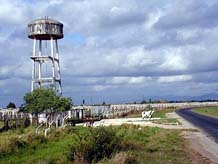
|
Still, there's an old joke in
Cuba: The three great successes of the revolution have been
medicine, education, and sport; the three great failures have
been breakfast, lunch, and dinner. This is a huge feedlot outside
Havana. It seemed to go on for miles. And it was completely
abandoned. We don't know if this resulted from lack of inputs
owing to the economic collapse of the 1990's -- or just bad
planning.
|
|
Some people told us that large
scale, collective agriculture in Cuba, as represented by the
defunct feedlot, simply doesn't work well. What does seem to
work, they said, is production by smallholders. Since 1994,
peasant farmers have been allowed to sell part of their production
in public markets for their own profit, and this has improved
the availability of food considerably.
|
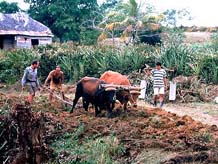
|
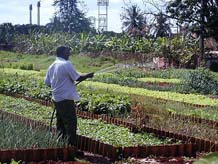
|
We saw intensively-cultivated
gardens like this all over the country, especially outside the
big, soviet-style apartment blocks that ring some of the cities.
|
|
A lot of the produce from these
gardens is rolled into the city centers on wheelbarrows or hauled
in carts and sold in the streets for pesos, as here in Santiago
de Cuba. Traveling by bike, we very often made meals of fruit
and other foods that we bought from street vendors.
|
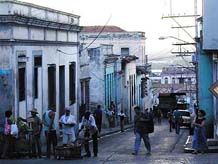
|
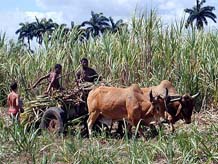
|
We were taught the saying, "Sin
sucre, no hay pais," without sugar, there is no country. We
were in Cuba during the months of the sugar harvest. Much of
the work was done with big machines -- but some of the cane
was still harvested by hand, and the less mechanized approach
was more photogenic.
|
|
Tobacco is also important to the
economy. The best tobacco comes from Pinar del Rio province,
and all the tobacco we saw appeared to be grown by small-scale
farmers. This farm is in the Vinales Valley. Leaves were dried
for a few days in the sun, then cured in the shade of the thatched
building.
|
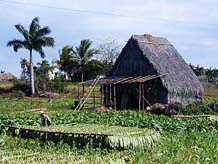
|
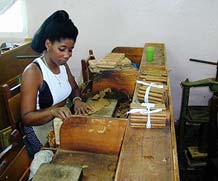
|
Cuban cigars are still rolled
by hand, and it is skilled work. We were interested to see that
Cuban cigar factories still employ "readers." At the front of
the room, someone reads aloud from newspapers, short stories,
even novels, to help workers pass the time and further their
education as well.
|
|





